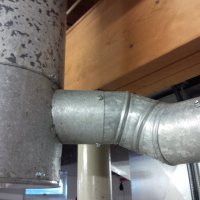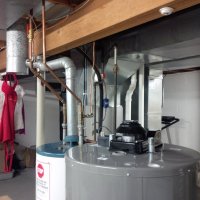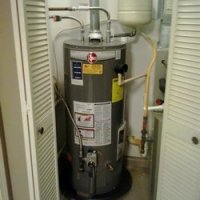I dont understand what the problem is or the question....
Just take out the old heater and re-use what you already got in place.
its the same size as what you need on that new unit so I dont know
what you are worrying about.....
it will work fine for another 25 years unless it is rotted out or rusted through.
that appears to be a 6 inch chimmney which is really a large chimmney for just the water heater venting , but it will work.. you might get some sweating in the winter time..
It looks like you have a stop on the hot side of the system but no shut off
in sight on the cold side ..... what gives with this,, was it plumbed backwards
or something???..
Thank you Mark, for your prompt reply. I appreciate it very much.
The "STOP" sign on the 45 year old Rheem WH (white in color) is actually off the new Rheem WH (gray in color) that I returned due to damage that was caused during warehousing or shipping. You can see in one of the photos the new Rheem. This photo was taken before I returned it. The "STOP" sign may be what is confusing you as I stuck it on the side opposite the control side where the gas pipe attaches. I didn't need this big warning sign because it's duplicated elsewhere on the new WH. I suppose I could have simply trashed the STOP sign.
Anyway, you can see the 3/4 SharkBite ball valve on the cold water inlet line. Below it is an old saddle valve someone had installed for water service to a refrigerator. I will replace this saddle valve with a SharkBite 3/4 inch push to connect X 3/4 inch push to connect X 1/4 inch compression service stop tee once I run the 3/4 cold water tubing down to the new WH when it arrives. The SharkBite 1/2 push to connect X 1/2 push to connect X 1/4 inch compression service stop tee you see on the hot water outlet tubing was put there to service a humidifier that is attached to the new Carrier furnace you see behind the two water heaters. It's installed on the hot water outlet tubing because the humidifier has its own fan and is controlled by the Carrier humidistat, even though it could have been wired to operate on its own as it's a digital control humidifier. There is no hot air duct going from the furnace plenum to the humidifier, thus the need for a hot water feed to the humidifier instead of a cold water feed. I'm going to replace all the copper tubing from the WH back to a distance about fifteen feet away. The existing copper tubing is Type M and is 45 years old so I'm replacing it with new Type L tubing. I'll eventually replace all the copper water tubing with Type L but this is a good place to start. I've already soldered the new copper tubing I'll be using although I prefer to use SharkBite fittings in certain locations in the event I have to dismantle part of the system for any given reason. I haven't connected any of it yet because I'm waiting on the replacement WH.
The double wall metal chimney you see at one time serviced both the old furnace (130,000 BTU installed in 1971) I replaced and the old water heater you see in the photos. It's oversized for what I'm using it for now but it apparently wasn't oversized at the time the house was built. You will notice that there is an insert in the bottom of the metal chimney, where the single wall 3 inch vent pipe is attached. This is what is confusing me. It measures appx. 7 inches in diameter. I'm supposing that the metal chimney is actually a 6 inch diameter chimney, 6 inch diameter for the inner wall and the 7 inch diameter being the outer wall. Am I correct? This is where I'm having a problem finding a 7 inch adapter that will accept the 3 inch Type L vent pipe through the side or the bottom. This 7 inch adapter would be inserted into the bottom of the chimney and could be either a T or a Y adapter. I'm not choosy.
I need to pull a permit for the WH and pass an inspection. This is why I have to change the 3 inch vent pipe. The current vent pipe configuration is not up to code and will not pass an inspection. The State of Ohio and my county have adopted Chapter 5 of the International Plumbing Code and the current vent setup is in violation due to the horizontal being too long and not having the proper rise and being too close to the joists. I want to replace it with Type L for two reasons. One, it's ugly and violates the IPC and two, I want to eliminate the chance of burns due to skin contact. If you look closely you'll notice that the top of the natural gas piping has a 6 inch piece of galvanized mixed in with the black iron pipe. I don't know if this violates the IPC or whichever mechanical or gas codes my state has adopted but I'm going to change this 6 inch piece to black iron pipe so I don't fail the inspection. The current gas piping was installed in 1971. I don't know why the Carrier installer didn't change this 6 inch galvanized piece when he installed the new furnace. The furnace inspection passed with flying colors. The new gas piping is already assembled and waiting for the new WH. I suppose I could do what many people do and install the WH without a permit and inspection. The penalty, if caught, would be for me to pay twice the cost of the permit and the water heater could stay provided it passed inspection but I'm a firm believer that codes are in place for a very good reason, which is safety.
There has to be adapters out there that I can use to connect the metal chimney and 3 inch Type L vent, leaving no 3 inch single wall vent pipe anywhere between the WH and the chimney. I basically need to know if my "7 inch" chimney is actually a 6 inch chimney and if a "6 inch adapter" is actually 6 inches diameter or 7 inches diameter.
Thanks again for your reply.
EDIT:
While sitting here looking online for an adapter I had a sudden bout of common sense and decided to nail down just what kind of metal chimney I have. I removed the plate off the bottom of the chimney insert and measured the diameter. This diameter is appx. 7 inches. I also measured the circumference, which is 56.2 centimeters, and converted this to a diameter of appx. 7 inches. Sixteen inches from the bottom of the chimney there is an outer wall. I measured the circumference, which is 61.2 centimeters, which converts to a diameter of appx. 7.7 inches. With the bottom plate off I looked up inside the chimney and there were no additional walls so this appears to be a double wall galvanized chimney.
Are you familiar with this type and size of metal chimney and do you know where I can get a T or Y adapter for it that will accommodate a 3 inch Type L vent pipe? It's not a 6 inch double wall chimney. Is it considered an 8 inch double wall chimney? I can't find any references to a 7 inch double wall chimney online. I've spent days online looking for one and hours in forums to no avail.

 atech and again, I don't know whether my metal chimney is actually considered a 7 inch chimney or a 6 inch chimney. Is my 7 inch metal chimney actually a 6 inch metal chimney, with the 7 inch measurement being the outer wall of a 6 inch inner wall chimney? Please excuse my ignorance.
atech and again, I don't know whether my metal chimney is actually considered a 7 inch chimney or a 6 inch chimney. Is my 7 inch metal chimney actually a 6 inch metal chimney, with the 7 inch measurement being the outer wall of a 6 inch inner wall chimney? Please excuse my ignorance.
